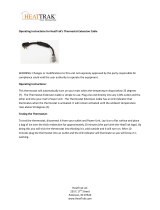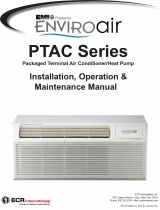
UNIT FEATURES
Fig. 2 - Model GA
This Premium unit has many exciting features which
are different than those found on standard PTAC
models. The owner must be familiar with these
features in order to fully understand the operation and
capability of the unit.
• Intelligence - Your Premium unit has an on board
computer that utilizes real time diagnostics to prolong
the life of your unit. There is an LED indicator on the
control board, behind the front panel, that will flash
an error code if the unit has detected some kind of
fault condition. In many cases, the unit will
automatically clear the fault condition and continue
operating with no interruption. In some cases, the
condition cannot be cleared and the unit will require
service. In those cases, an "Fx" failure mode will be
displayed on the digital display. For a detailed list of
all error codes and "Fx" conditions, see Table 6 -
Status LED Indicator Definitions for further details.
. Memory - Your Premium unit also has memory. If
power is lost, all of the control settings (setpoint,
mode, fan speed, on/off and configuration) are
remembered. So when power is restored, the unit will
start back up in the mode (and configuration) it was
in, when power was lost.
. Premium Sound - Your Premium unit is also
the quietest PTAC ever. Not only does it have 2
fan motors and a tangential blower wheel for
optimum sound, the indoor fan will always run a
minimum of 10 seconds before the compressor, to
help reduce any compressor starting noise.
. Random Compressor restart - To help prevent
power surges after a power outage (from many of
your PTACs starting at the same time), the
compressor is equipped with a 2:45 to 3:15 random
restart delay feature. Whenever the unit is plugged in,
or power has been restarted, a random compressor
restart will occur.
. Compressor Protection - To prevent short cycling
of the compressor and maximize it's life, there is a
random start-up delay of 3 minutes on the
compressor and a minimum compressor run time of 3
minutes.
. Automatic room freeze protection - automatically
will keep the temperature in the room from getting
too cold, where water pipes might freeze. If the unit
is configured for the freeze protection feature to be
active (which is the default condition), then whenever
power is supplied to the unit, if the unit senses
temperature below 40°F (4.4°C), the fan motor and
electric heater are turned on and will warm the room
to 50 ° F (10°C). If Freeze protection is not required,
change the configuration switch to turn the feature off
(see section on unit configuration).
. Automatic defrost protection (for heat pump
models only) - When the outdoor temperature gets
too cold (approx. 40°F / 4.4°C) and the unit can no
longer effectively heat with the compressor, the unit
will automatically switch to electric heating. The unit
will then heat with electric heat until the outside
temperature rises enough (approx. 40°F / 4.4°C), so
the compressor can be used again.
. Automatic Quick Warm-up (for heat pump
models only) - If the room temperature falls to 5°F
(2.8°C) below the set point temperature, the reverse
cycle heat is shut off and the electric strip heat is
turned on for one cycle, until heating is satisfied.
. LED Indicator's and Buttons - The touch pad has
buttons for MODE, FAN SPEED, ON/OFF,
SETPOINT UP and SETPOINT DOWN. It also has
LEDs that correspond to the mode, fan speed and
setpoint operation, to indicate the unit's status. The
LEDs below the mode button, FAN, COOL, and
HEAT, indicate what operating mode is active. The
LEDs below the Fan button, Low, Med and Hi,
indicate the fan speed that is selected. The LED
located in the lower right corner is the unit On/Off
status LED. If the unit is in ON mode, the LED will
be green. If the unit is OFF, the LED will be red.
. Configure Fan to Optimize Selected Application -
Unit can be optimized to selected application by
configuring the fan to run in continuous mode or cycle
on and off with the compressor and electric heater (can
be different for both heating and cooling modes). In
cycle mode, fan will continue to run 60 seconds after
compressor or electric heater stops in order blow off
any residual heat or coo! left on coi!.






















